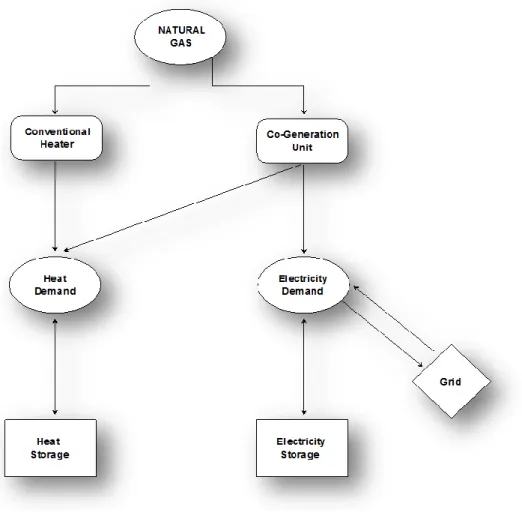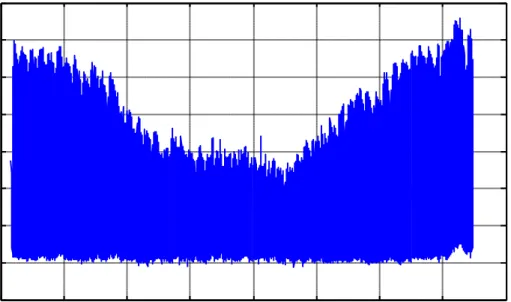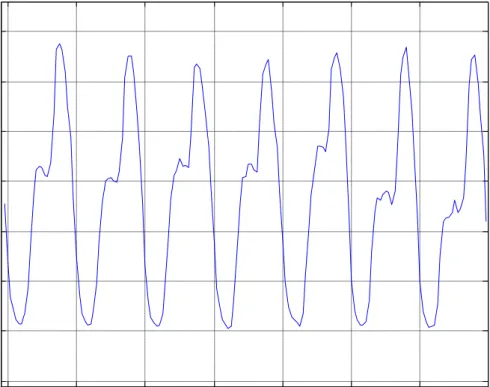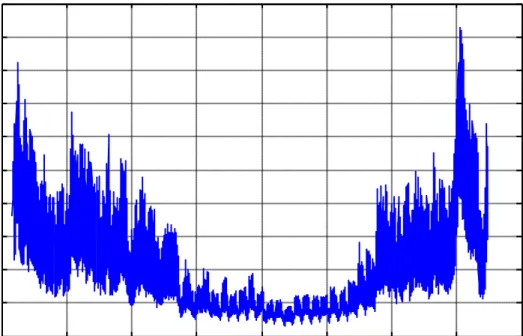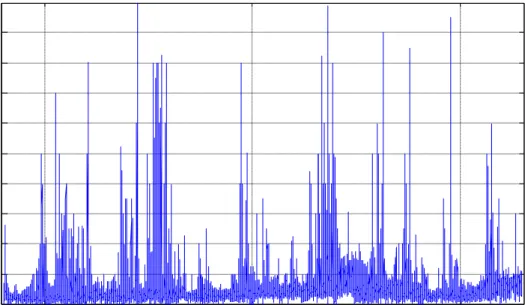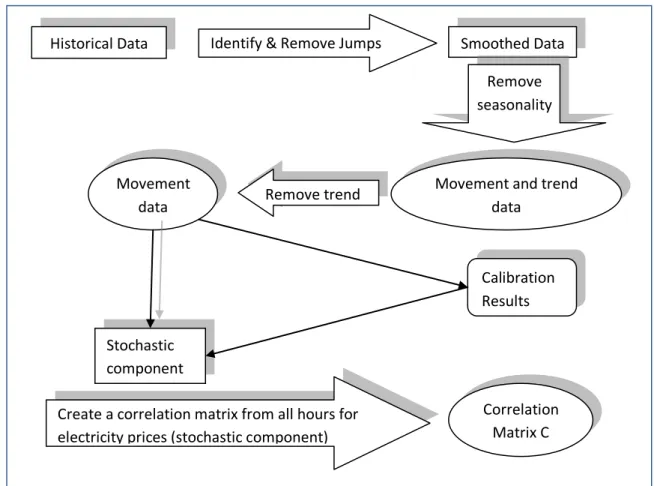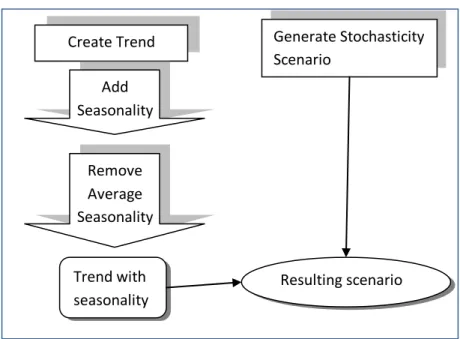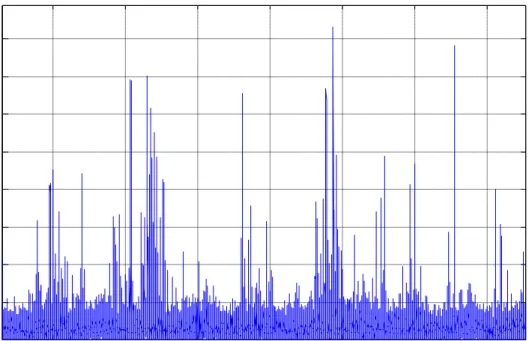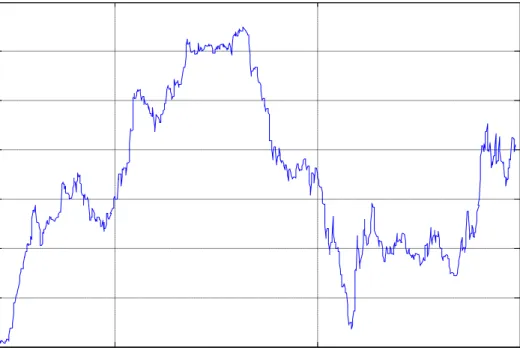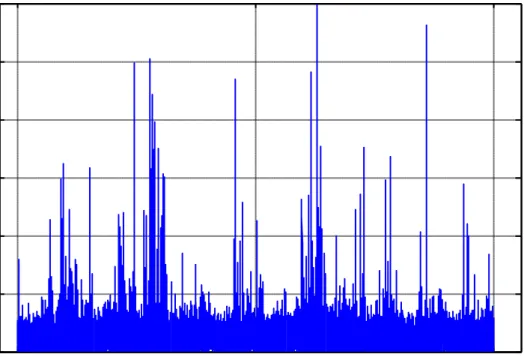MODEL FOR VALUATING DECENTRALIZED ENERGY PRODUCTION A Master‟s Thesis by MUAMMER CĠDER Department of Economics Bilkent University Ankara October 2008
MODEL FOR VALUATING DECENTRALIZED ENERGY PRODUCTION
The Institute of Economics and Social Sciences of
Bilkent University
by
MUAMMER CĠDER
In Partial Fulfillment of the Requirements for the Degree of MASTER OF ARTS in THE DEPARTMENT OF ECONOMICS BĠLKENT UNIVERSITY ANKARA October 2008
I certify that I have read this thesis and have found that it is fully adequate, in scope and in quality, as a thesis for the degree of Master of Arts in Economics.
---
Assistant Prof. Dr. Taner Yiğit Supervisor
I certify that I have read this thesis and have found that it is fully adequate, in scope and in quality, as a thesis for the degree of Master of Arts in Economics.
---
Associate Prof. Dr. Fatma Taşkın Examining Committee Member
I certify that I have read this thesis and have found that it is fully adequate, in scope and in quality, as a thesis for the degree of Master of Arts in Economics.
---
Associate Prof. Dr. Süheyla Özyıldırım Examining Committee Member
Approval of the Institute of Economics and Social Sciences
--- Prof. Dr. Erdal Erel Director
iii ABSTRACT
MODEL FOR VALUATING DECENTRALIZED ENERGY PRODUCTION Cider, Muammer
M.A, Department of Economics
Supervisor: Assistant Prof. Dr. Taner Yiğit
October 2008
The purpose of this thesis is to assess decentralized production technologies in an economical framework. Throughout the thesis, technological aspects such as smart metering or connectivity issues are ignored. All assumptions are based on specification sheets by the producers of the technologies to provide an impartial assessment.
Pricing schemes for buying from the grid and selling to the grid are based on dynamic markets, like Amsterdam Power Exchange and Title Transfer Facility. Although these markets are for large scale trading, they provide a good basis for constructing future scenarios where electricity and gas are bought on variable prices rather than fixed prices.
Model constructed to evaluate different technologies finds the optimal production given the technologies and prices for the period. Optimal production clearly defines an upper bound on the value of the technology as any other production increases the cost of heat and electricity of the household.
In retrospect, model establishes a best case scenario for the value of such systems from an economical perspective. Technological, regulatory, and marketing aspects are
iv
not explored in this study. Only economical viability of the technologies is explored. In summary, it is common for individuals to make misinformed or wrong decisions. Effects of marketing etc. can be studied, but my belief based on this study is that these devices are not economically viable and their environmental benefits are questionable.
Key Words: Energy, Valuation, Decentralized, Optimization, Combined Heat and Power, Renewable energy generation, Sustainable Development.
v ÖZET
DAĞINIK ENERJĠ ÜRETĠMĠNĠN DEĞERLENDĠRĠLMESĠ ĠÇĠN MODEL Cider, Muammer
Yüksek Lisans, Ekonomi Bölümü Tez Yöneticisi: Yrd. Doç. Dr. Taner Yiğit
Ekim 2008
Bu tezin amacı dağınık enerji üretim sistemlerinin kullanılabilirliğini ekonomik bağlamda incelemektir. Tezin tamamında, teknolojik veya lojistik özellikler dikkate alınmamıştır. Tezin tarafsızlığını koruması amacıyla kullanılan bütün spesifikasyonlar üreticilerin kendi dökümanlarından alınmıştır. Tez boyunca varsayılan enerji piyasası dinamik bir market olarak kabul edilmiştir. Günümüzde bu tip piyasalar genel olarak büyük ölçekli borsalarda işlem görmektedir, ancak küçük ölçekli kullanıcılar için böyle bir piyasa bulunmadığı için, piyasa durumlarının oluşturulması bu marketlerden esinlenerek yaratılmışır.
Değişik teknolojileri değerlendirmek için kullanılan model, piyasa fiyatları ve teknolojilerin verimliliğini kullanarak optimal değer bulmayı amaçlar. Bu optimal değer ekonomik olarak teknoloji için olabilecek en iyi değeri verecektir. Bunun sebebi açıktır, herhangi başka kullanım evin enerji harcamasını arttıracaktır.
Araştırma için baz alınan ülke Hollanda olarak belirlenmiştiri bunun sebebi gerekli bilgilerin bu ülke için kolay erişilebilir olmasıdır. Araştırmanın sonuçları Hollanda için bu teknolojilerin şimdiki duruma yeterli bir iyileştirme sağlıyamadığı yönündedir.
vi
Bunun sebepleri tezin geri kalan kısmında detaylandırılmıştır fakat en önemli nokta Hollanda‟daki ev enerji veriminin yüksek olmasıdır.
Kısaca, model teknolojiler için olabilecek en iyi şekilde ekonomik bir analiz yapar. Teknolojik, regulasyon gibi etkenleri ele almadan sadece ekonomik bir analiz yapar. Ġnsanların ekonomik olarak yanlış kabul edilebilecek yatırımlar yaptığı bir gerçektir. Bu sebeple tekrar belirtmek isterim ki bu tez sadece teknolojilerin olası finansal gelirini inceler.
Anahtar Kelimeler: Enerji, Dağınık, Optimizasyon, Isı ve Güç, Yenilenebilir Enerji Üretimi, Sürdürülebilir Kalkınma.
vii
ACKNOWLEDGEMENTS
I would like to thank my family from the bottom of my heart for their relentless support through the whole process.
viii
TABLE OF CONTENTS
ABSTRACT...iii ÖZET...v ACKNOWLEDGEMENTS...viii TABLE OF CONTENTS...ix LIST OF TABLES... xiLIST OF FIGURES ...xii
CHAPTER I: INTRODUCTION...1
CHAPTER II: MODEL OVERVIEW...3
2.1 Price Models...4
2.2 Demand Models...5
2.3 Production Model...5
2.4 Valuation methodology...6
CHAPTER III: DEMAND...7
3.1 Electricity Demand...7
3.2 Heat Demand...10
3.3 Possible Extensions...12
CHAPTER IV: PRICING AND STIMULATION...13
4.1 Properties of Electricity Spot Prices...15
4.2 Employed Methods...16
4.2.1 Historical Sampling...16
4.2.2 Methodology...17
4.2.3 Mixture Models...18
4.2.4 Ornstein-Uhlenbeck Model with Correlated Jumps...18
4.3 Methodology...18
ix
4.5 Market Prices to Consumer Levels...23
CHAPTER V: OPTIMIZATION MODEL...27
5.1 Why use optimal values?...27
5.2 Finding the Optimum...28
5.2.1 Limitations...33
5.2.2 Model Validation...33
CHAPTER VI: TECHNOLOGIES...35
6.1 Perpetual Generation Devices...36
6.1.1 Solar Panels...36 6.1.2 Wind Turbines...37 6. 2 Cogeneration Devices...37 6.2.1 Stirling Engines...38 6.2.1.1 Modeling Side...38 6.2.2 Fuel Cells...39 6.2.2.1 Modeling Side...39
6.3 Additional Design Components...39
6.3.1 Electricity Storage...39
6.3.2Heat Storage...40
6.4 Tested Technologies...40
6.4.1 WhisperGen Stirling Engine (on-grid)...40
6.4.2 Ceres Fuel Cell (Alpha Unit)...41
6.4.3 CFCL Fuel Cell (Net~Gen)...41
6.4.4 AVA Solar Inc. Solar Panel...41
6.4.5 Bergey Micro Wind Turbine (Bergey XL.1)...42
CHAPTER VII: SCENARIOS...44
7.1 Normal Electricity Demand...48
7.1.1 Effect of Gas Price...50
7.1.2 Effect of Electricity Price...53
7.1.3 Effect of the Spark Spread...55
7.1.4 Summary...57
CHAPTER VIII: RESULTS...58
8.1 Ceres Fuel Cell...58
8.1.1 Summary...62
x
8.2.1 Summary...66
8.3 WhisperGen Stirling Engine...67
8.3.1 Summary...69
8.4 AVA Solar Inc. Solar Panel...70
8.4.1 Summary...70
8.5 Bergey XL Wind Turbine...71
8.5.1 Summary...71
CHAPTER IX: SUMMARY, CONCLUSIONS AND RECOMMENDATIONS...72
9.1 Gas Prices...72 9.2 Electricity Prices...73 9.3 Utilization...73 9.4 Results...74 9.5 Summary...74 9.6 Conclusions...76 REFERENCES...78 APPENDICES...80
Appendix A: Consumer Adjusted Price...80
xi
LIST OF TABLES
Table 1: Capacity and Efficiency Table...32
Table 2: Summary Table...42
Table 3: Scenarios...45
xii
LIST OF FIGURES
Figure 1: Model Overview...3
Figure 2: Annual Demand Variation...8
Figure 3: Hourly Electricity Demand Variation...9
Figure 4: Annual Heat Demand Variation...11
Figure 5: Weekly Heat Demand Variation ...11
Figure 6: Historical Electricity Spot Price Data...16
Figure 7: Calculating Correlation of Electricity Price Movements...20
Figure 8: Generation of Scenarios...21
Figure 9: Generated Base Case Scenario...22
Figure 10: Historical Gas Spot Prices...23
Figure 11: Generated Consumer Price Scenario for Electricity...24
Figure 12: Generated Base Case Scenario for Natural Gas...25
Figure 13: Consumer Adjusted Scenario...26
Figure 14: Natural Gas Scenario for Ceres Fuel Cell...46
Figure 15: Electricity Price Scenarios for Ceres Fuel Cell...47
Figure 16: Upper and Lower Bound for Cost of Energy for no CHP...49
Figure 17: Upper and Lower Bound for Cost of Energy for Ceres FC....50
Figure 18: Base Case Electricity Scenario for Ceres FC...51
Figure 19: Negative Cash Flow Variance under Different Natural Gas
pricing Scenarios...52
Figure 20: Negative Cash Flow Variance under Different Natural Gas
pricing Scenarios for Ceres FC...53
xiii
Figure 22: Similar Spread Scenarios...56
Figure 23: Dissimilar Spread Scenarios...57
Figure 24: Electricity Supplies for Ceres CHP with Electricity Storage..59
Figure 25: Supply and Demand...60
Figure 26: Ceres Heat Supplies...61
Figure 27: Seasonal Variation in Ceres FC Utilization for Normal
Demand...61
Figure 28: CHP Utilization for Ceres FC with High Demand...62
Figure 29: Electricity Production...63
Figure 30: Heat Supply and Demand for High Electricity Demand...64
Figure 31: Heat Supply and Demand for High Electricity Demand with
Heat Storage...64
Figure 32: Heat Production for High Electricity Demand with Heat
Storage...65
Figure 33: CFCL FC Utilization under Normal Demand...65
Figure 34: CFCL FC Utilization under High Demand...66
Figure 35: Electricity Supply with WhisperGen SE...67
Figure 36: WhisperGen Utilization under Normal Demand...68
Figure 37: WhisperGen Utilization under High Demand ...69
Figure 38: Wind Speed vs. Power Coefficient (Iowa Energy Center,
2006)...82
Figure 39: Energy Produced vs. wind Speed...83
Figure 40: Hourly Solar Insulation...85
1
CHAPTER I
INTRODUCTION
Heat and electricity are two of the most important components of modern life. Until now people relied on utility companies to provide these two necessities of modern life; however, several emerging technologies are promising to change this arrangement. It is claimed that small scale energy production technologies have reached efficiencies to rival the existing centralized energy production plants.
Current outlook on fuel and energy prices start to show the effects of dwindling supply on fossil fuels, and the considerable increase in demand from developing nations. Increased cost of energy resources demand that we extract maximal value from these commodities, increasing overall energy efficiency is a definite improvement in this venue.
There seems to be room for improvement, current installed technology in households with a HR-Boiler convert about 95% of the available energy in natural gas to useable heat energy. Electricity on the other hand, is a completely different issue; for example Dutch electricity production and transport is only 40% efficient, this efficiency drops down to 25-30% for Turkey. This means 60-70% of the energy is lost from resource to usable electricity.
2
Purpose of this paper is to construct a framework to evaluate viability of emerging technologies in decentralized energy production. It is important to establish what individuals will base their decisions upon. People hardly ever consider the bigger picture when making decisions, countless taught experiments show that one‟s economic benefits will govern his/her decision over the public benefits. Tragedy of the commons (Hardin, 1968) is a well established taught experiment having its roots back in the days of Socrates. Brief result of the article is, individual maximize their own gains, common resources that are unregulated and freely available will not be considered. In the case of energy production, environmental impact is this common resource. It is safe to assume individuals will try to maximize their own utility by minimizing energy cost of the household.
This paper evaluates emerging technologies on a purely economical sense. It is my belief that any significant concern for environment will be fueled by economical incentives, such as emissions penalties, any adjustment on this regard will be done in the pricing.
It is also important to establish how wide spread use of decentralized production will affect pricing schemes. It is the expert opinion that current pricing schemes will not work with a market saturated by decentralized production, thus markets are assumed behave more like a commodity market. Luckily examples of these exist in large scale; all market behavior is modeled after these large scale implementations.
Economical viability of these technologies will ultimately determine their impact on the market. If these technologies do not prove to be viable economically, it is unlikely that they have an impact on the market. There might be several occurrences; however, it is my belief that any significant impact must be fueled by economic motives.
3
CHAPTER II
MODEL OVERVIEW
In order to determine the value of a production system, one has to model the behavior of the system for various inputs. In the case of production systems the valuation can be done by assuming the best possible utilization of the production unit for the given set of inputs.
Assumption of optimality is both necessary and logical; underlying decisions for operating a production system is likely to include too many decisions for the end-user. Under this supposition it is only logical to assume an automated system will be making these decisions instead of the end-user. Optimal decision will be made with the purpose of minimizing overall cost of energy, regardless of the user.
The model is divided into three parts; namely: 1. Production optimization.
2. Electricity and heat demand models. 3. Electricity and gas price models.
The value of the system is determined by the production optimization part using deterministic values from the demand and prices.
4
Overall, the working of the system can be summarized in the following figure.
Figure 1: Model Overview
The production model encompasses decisions made for production from the cogeneration device and the conventional heater as well as the storage interactions. Demands, grid prices (electricity buy and sell prices) and natural gas are deterministic inputs to the production system.
2.1 Price Models
The main purpose of the price model is to model the electricity grid price and the natural gas price, so that a stochastic model can be constructed. This stochastic model
5
can then be used to create scenarios for electricity and gas prices in the future, with specified trends.
Some important properties of the price models are:
The price model uses historical data to construct a stochastic model.
Model assumes an Ornstein-Uhlenbeck process as the basis for random movement of prices.
Price models uses trend of the future as input and generates scenarios based on the future annual values, it does not attempt to model future trend of prices. Movements on the pricing curves are based on historical prices.
2.2 Demand Models
In addition to the price models, demands for electricity and heat also play an important role in determining the value of any technology; these variables are not generated. In the model these variables are exogenous, i.e. simply taken as given. Slight manipulation on these variables might be required to model different technologies such as solar panels or micro-wind turbines. Demand growth (electricity) and reduction (heat) in the future is taken into account, using external documents as reference sources.
2.3 Production Model
The production model determines the optimal production from the cogeneration device and the conventional heater. Optimal decision parameters are calculated using
6
the demands and outputs of the price model. In the figure, the production model encompasses all but the demand, grid and natural gas. Details of the Production model are discussed further in upcoming chapters.
Some important properties of the production model are: Model uses deterministic inputs.
Different devices are modeled by specifying different efficiencies and capacities.
Heat and electricity can be turned off.
Optimization period is defined by the length of the input.
2.4 Valuation methodology
The value of a technology should be determined by analyzing the negative cash flow generated by the device and comparing it to the negative cash flow generated by the base case. The base case for testing technologies should be no co-generation device and a high efficiency boiler. Net present value of the negative cash flows should be aggregated over the analysis period of the device to find total cost of energy over this period. This value can then be compared to the base case total cost of energy. Additional costs such as maintenance costs over the analysis period should be accounted for in the analysis.
7
CHAPTER III
DEMAND
Energy demand is an important aspect of the system that plays an important role in the total value of the system. Only heat and electricity demand are taken into account within the model. Heat demand is not further subdivided into hot water needs and spatial heating to prevent further assumptions.
Electricity and heat demand are assumed to be inelastic; this choice was made to avoid cross-interaction with prices. Although not entirely true, this assumption holds for the most part, as altering the daily routine such as showering in the morning or washing the dishes at night are very minor compared to overall energy expenditure.
3.1 Electricity Demand
Electricity demand should be deterministic input to the model, as such percentile values for expenditure must be scaled to annual consumption levels, to account for this change demand forecast curves are scaled to the annual average for EU households, estimated at 3500 (EnergyNed, 2007). It is estimated that electricity consumption will experience a steady increase of 1.3% over the next decade, after 2016 electricity demand is expected to stay constant through the rest of the analysis period.
8
Usually the annual demand follows a U shape with minimal electricity consumption during the summer; this is not the case for nations that rely heavily on air-conditioning; the seasonality effect can easily be seen in the figure below.
12/24 02/12 04/02 05/22 07/11 08/30 10/19 12/08 01/27 0.1 0.2 0.3 0.4 0.5 0.6 0.7 0.8 0.9 Date mm/dd H ou rly D em an d kW h
Annual Demand Variation
Figure 2: Annual Demand Variation
Note that regardless of the season, there is significant hourly and daily variation within the demand, which is best illustrated in this figure. One can easily identify the peak hours when the users are home and off-peak hours when the users are either sleeping or out of the house.
9
Sun Mon Tue Wed Thu Fri Sat
0.1 0.2 0.3 0.4 0.5 0.6 0.7 0.8 Day H o u rl y E le c tr ic it y D e m a n d ( k W H )
Weekly Electricity Demand Variation
Figure 3: Hourly Electricity Demand Variation
Electricity demand can be manipulated to account for solar or wind generation to model these devices. This is done by first forecasting production from the device and then simply subtracting this amount from the electricity demand. When there is excess production, demand will be negative fortunately the model can account for negative demand, simply selling it to the grid or if possible storing it.
The model is tested under the demand scenarios shown above. This demand profile is taken from measurements over a year from a single household.
10 3.2 Heat Demand
Unlike electricity demand, heat demand cannot be measured directly. Several approaches were employed to determine heat demand of a residential house, control room data and natural gas demand were the most successful attempts at modeling the heat demand.
Heat demand was modeled after the natural gas demand curves, currently 97% of the overall natural gas demand is for heating (EnergyNed, 2007), either hot water or spatial, 3% of the gas usage accounts for cooking. This assumption was later confirmed by the control room data, control room data could not be used to create the demand profile. Control room data was missing data from the winter months, which are the most important days for heat demand. A simple correlation between control room data and natural gas demand data, gives a correlation coefficient of 0.95, further confirming the close relation between heat and gas demand.
Similar to the electricity demand, heat demand also exhibits seasonal and weekly behavior. Figure 4 depicts the annual change in heat demand, heat demand during the summer months are attributed to hot water demand of a household.
Weekly heat demand variation is depicted in Figure 5; showering needs in the morning can easily be identified by the spike occurrence during the morning hours.
11 12/240 02/12 04/02 05/22 07/11 08/30 10/19 12/08 01/27 0.5 1 1.5 2 2.5 3 3.5 4 4.5 5 H ou rly H ea t D em an d (k W h) Date mm/dd
Annual Heat Demand Variation
Figure 4: Annual Heat Demand Variation
Sun Mon Tue Wed Thu Fri Sat
1.5 2 2.5 3 3.5 4 4.5 Day H o u rl y H e a t D e m a n d ( k W h )
Weekly Heat Demand Variation
12
Heat demand is assumed to remain constant in a residential house during the analysis period (2010-2020). Main differentiator for heat demand is insulation and efficiency of the boiler. Due to the fact that efficiency of the boiler is accounted for within the model only differentiator is insulator. Heat demand has shown a significant decrease at the start of the 21st century but has been stagnant for the last five years (Energy Information Administration, 2007).
3.3 Possible Extensions
The model can further be extended to include behavioral interaction between demands and prices; modularity of the model eases the adaptation of this extension. Current implementation of the model disregards any behavioral implication of high prices, in layman‟s terms the demand is taken as purely inelastic regardless of the prices.
Deterministic nature of the demand and optimization model do not allow any other type of input, however this functionality can easily be implemented deterministically, since the prices and demand are generated prior to passing them into the optimization model.
13
CHAPTER IV
PRICING AND STIMULATION
The production model uses deterministic inputs to determine the optimal production scheme that satisfies demand. A reasonable assumption would be to have the output of the pricing model to be deterministic. However, pricing model is stochastic. Making the model stochastic was necessary to ensure that generated scenarios used to valuate different devices were truly random.
Forward curves are used as the basis for generating pricing scenarios of commodities. Forward curves lack the short term behavior that spot markets entail. In order to construct a realistic pricing scenario both the long term and the short term behavior must be accounted for. This is done by modeling short term behavior on historical spot markets and leveling them to the forward curve levels.
Natural gas prices and electricity commodity prices are the outputs of the pricing model that is used in the production optimization model. Natural gas is the fuel for all of the devices analyzed in this study that use some form of fuel and as such it is an important determinant for the value of these devices. Electricity price is the price at which this commodity can be bought or excess production can be sold to the market. It too is a very important driver for value as it plays a significant role in determining when and how much to produce with the CHP unit.
14
There are two distinct way of generating scenarios for the price of a commodity in a given period, the first one is constructing a complete model from the ground up. This involves determining factors that affect the commodity price and build the model for that commodity accounting for these factors. The second way of constructing scenarios involves a “blind approach”, looking at the historical data and analyzing the data as is, without constructing a complete model from scratch.
Historically, constructing robust models for natural gas prices and electricity prices have been notoriously hard (Brown & Yucel, 2007). Numerous papers were written on the subject, there are no models that have warranted universal acceptance for these commodities.
The energy crisis, has only added fuel to the fire that is forecasting energy commodities. In order to generate scenarios, a mid-way approach was employed. Several approaches were tried to construct these scenarios, at the end only one of these methods was satisfactory both mathematically and rationally.
Predicting the future course of prices is beyond the scope of this thesis. Natural gas prices are known to be tedious to predict, as they are coupled with crude oil, fuel oil and other energy commodity prices, and increasingly dependent on supply. Publicly available forecasts from third parties are used for calculations. These forecasts however do not encompass the dynamic movement that the market faces in the real world; they are a single average value for the whole year.
The production model uses hourly prices for electricity and gas to determine the optimal production scheme to use. Historical movements are a good starting point for modeling this dynamic behavior of the prices.
15 4.1 Properties of Electricity Spot Prices
There are several very important points that cannot be overlooked when constructing movements from market prices. Historical data for electricity prices for a residential house is contractual in nature (one price per quarter).
Although dynamic market is an hourly market, each hour behaves as a different commodity; this is mainly due to the fact that electricity prices are mostly driven by demand and electricity cannot be stored effectively.
Electricity prices of different hours are different commodities, but there is a strong correlation between movements.
Electricity and gas prices might be interlinked; a spike in gas price might drive electricity prices higher.
Gas and electricity prices exhibit historical mean reversion until 2002, over the period 2002-2008 gas price behavior has shifted towards an increasing trend. There is seasonality of prices.
16 02/07/02 01/01/05 02/07/07 100 200 300 400 500 600 700 800 900 Date E ur o/ M W h
Historical APX Data (hourly)
Figure 6: Historical Electricity Spot price data
Historical Electricity spot price data is shown in the figure, this general shape is what we aspire to have at the end of the simulation.
4.2 Employed Methods
It has been a daunting task to construct pricing scenarios that are both mathematically sound and intuitively acceptable. Several different methods were used to generate these scenarios. This section details different methods that failed and one that succeeded.
4.2.1 Historical Sampling
Most logical course of action to construct a dynamic model dependent on historical movements is historical sampling. Idea behind this is simple; pick a day in the
17
historical data that has the same seasonal properties with the forecasted day until you have a complete series that spans 2010-2020.
Due to random picking of days, changes in the prices instead of the prices itself must be used.
4.2.2 Methodology
In order to prevent a general trend from emerging, data must be free of all annual trends; trend is removed by fitting linear lines through each year and subtracting it from the data. This was accomplished by spline toolbox in MATLAB; spline toolbox can employ several methods to fit different kind‟s constructs onto a data series (Mathworks, 2007). In order to have a linear fit with 3 different trends, order of 2 is used for the fit, which defines a linear line and since the historical data is 3 years for gas and 6 years for electricity custom knot points relating to start, end and each January 1st in the data are used.
Sampling is done on the de-trended data, each week is put into a bin with similar properties and a random sample is chosen from the respective bin corresponding to the day that is constructed. Weeks are sampled to preserve spike and seasonal behavior. Trend for the future dates are constructed from forecasted values, a running multiplication on the trend is then performed by the sampled values to reach a final scenario.
Due to multiplication of changes the resulting scenario may have extreme peaks and areas of little to no activity. Historical sampling fails to provide neither a mathematical model nor an intuitive result.
18
4.2.3 Mixture Models
In quantitative finance, there are several accepted models for pricing commodities. None of these models seems to give respectable results for current state of energy prices. An idea that was employed to create a stochastic model for prices was using a Ornstein-Uhlenbeck model with jumps dictated by a distribution from 2 Gaussian distribution, each of which account for different aspect of the pricing.
Although this model provided some intuitively acceptable results, mathematics behind Ornstein-Uhlenbeck process does not support mixture models for stochasticity.
4.2.4 Ornstein-Uhlenbeck Model with Correlated Jumps
Simplicity usually yields the best results, however accounting for different aspects of energy prices usually makes simple approaches impossible. Keeping the model simple while accounting for the four facts stated above was the challenge of this approach, however resulting model is both intuitively satisfying and mathematically sound. As this is the pricing scenario model used to create the test cases, methodology will be explained exhaustively.
4.3 Methodology
Starting off with the problem of the link between electricity price and natural gas prices, one has to reach a theoretical consensus if a spike in one of these markets affects the other market. The Chi-Square Independence Test is generally used to determine links between two data sets and if anomalies between them are independent
19
of each other or not. Performing the test shows that there is no significant evidence that a spike in one market has an effect on the other one. Thus, gas pricing model and electricity pricing model can be constructed separately.
Both electricity and gas prices exhibit significant seasonality. In addition to seasonality electricity also exhibits significant day movements. This problem is tackled by removing these seasonality effect with regressing on dummy variables and taking the error term as the base movement. In the case of electricity the regression involves daily dummy variables as well as seasonal dummy variables.
Over the course of the last 5 years energy prices have gone up significantly, mainly due to unrest at the regions producing these commodities. The rise in these prices has also driven up electricity prices. Forecasted levels already take these into account and project a likely path that the prices would follow, so it is imperative that this behavior is removed from the prices. Spline toolbox is used to fit lines for each half-year, fitted line is removed to get rid of this behavior.
The Chi-Square test performed on the electricity and gas prices showed that there was no significant evidence of spike interaction between these markets. This fact is not true for electricity prices for different hours; electricity prices for each hour behave as individual commodities with significant correlation among each other. This relationship between hourly historical prices is replicated with the stochastic model; generated scenarios have the same correlation between different hours. An important point to note here is that correlation between these components has to be derived, as the historical correlation is between different but correlation between is required for simulation purposes.
20
Mathematically speaking, pricing model for gas and electricity follow the general Ornstein-Uhlenbeck process:
Undoubtedly simulation cannot be done on continuous time, discrete time representation of the Ornstein-Uhlenbeck process is:
Scientifically speaking the parameters for mean-reversion rate, the mean and volatility have to be estimated from the historical data, this can be done using a least squares regression(van den Berg, Calibrating the Ornstein-Uhlenbeck Model, 2007).
Historical Data Identify & Remove Jumps Smoothed Data Remove seasonality
Movement and trend data Remove trend Movement data Calibration Results Stochastic component
Create a correlation matrix from all hours for electricity prices (stochastic component)
Correlation Matrix C
21
The correlation matrix C is then used to create 24 correlated series with correlations between them equal to the correlation matrix C. This is done using the Cholesky decomposition of the correlation matrix; the resulting matrix can be used to generate correlated series from uncorrelated series by a simple multiplication (van den Berg, Generating Correlated Random Numbers, 2007). Figure 7 illustrates this process. Natural gas price fundamentals are calculated in a similar manner, since there is only one series of data for natural gas prices, the correlation matrix is not calculated and the generated data uses a random series of normally distributed random numbers, in line with Ornstein-Uhlenbeck literature. Figure 8 illustrates the generation of scenarios, the stochastic component for gas is not correlated with any other variable, thus can be generated separately, and the electricity prices‟ stochasticity is generated using the method described above. Note that the average seasonality has to be removed as this is already accounted for in the generated trend.
Create Trend Generate Stochasticity Scenario Add Seasonality Trend with seasonality Resulting scenario Remove Average Seasonality
22 4.4 Generated Scenarios
There are six different forward curves, which are on an annual basis, since these lack monthly variation (seasonality); seasonal variation has to be added manually. Trend is created from the forward curves; average adjusted seasonality1 is added to this trend to account for seasonal variation. Finally, random noise, modeled from historical data, is added to create resulting market pricing scenario. The base case is illustrated below, note that this price is not the consumer adjusted price, rather the true market price, these levels will have to be adjusted before passed into the production model. Figure 9 illustrates a generated scenario under this simulation scheme.
28/12/10 11/05/12 23/09/13 05/02/15 19/06/16 01/11/17 16/03/19 200 400 600 800 1000 1200 1400 1600 Date E ur o/ M W h
Basecase for Electricity
Figure 9: Generated Base Case Scenario
1
Average seasonality is set to zero; this is done to normalize seasonality to zero since average seasonality is accounted for in the forward curves.
23
The historical gas prices have also been contractual in nature for natural gas, it is the expert opinion that this pricing scheme cannot be maintained with increasing demand due to production at decentralized locations, as such market prices are a good historical base to simulate short term behavior of future scenarios.
01/01/06 01/01/07 18 20 22 24 26 28 Date P ric e
Historical TTF Prices for Gas
Figure 10: Historical Gas Spot Prices
4.5 Market Prices to Consumer Levels
Market prices are only a part of the total price for electricity, taxation and delivery costs usually drive prices up. One beneficial property of taxes and delivery prices is that they are linear with respect to the amount delivered, as the fixed cost of connection is usually taken care of during contracting. This fact means that one can
24
scale up or down the price and conserve the taxation and delivery costs inherent in the price.
Currently natural gas contract price for residential homes are calculated over fuel oil averages over a six month period that is lagged two months. Pricing scheme is changed completely, so the new consumer adjusted price has to be established from the market prices.
Over the last few years, fuel oil index prices are being adjusted to match the market. This fact presents a unique opportunity for calculating consumer adjusted price. Appendix A shows the details of the calculation of the consumer adjusted price from the current customer prices.
01/01/10 01/01/15 01/01/20 0 1 2 3 4 5 6 Date E ur o/ kW h
Consumer Adjusted Prices for Generated Basecase Scenario Between 2010-2020
25
A generated scenario for the base case gas scenario is illustrated in Figure 11. The consumer adjusted levels are again different from this figure; the consumer adjusted levels are illustrated in Figure 13.
01/01/10 01/01/15 01/01/20 5 10 15 20 25 30 Date P ric e
Generated Basecase Scenario for Natural Gas
26 01/01/10 01/01/15 01/01/20 0.01 0.02 0.03 0.04 0.05 0.06 0.07 0.08 0.09 0.1 Date E ur o/ kW h
Consumer Price Adjusted Generated Basecase Scenario for Natural Gas
Figure 1: Consumer Adjusted Scenario
The difference from the historical market case arises from the fact that gas prices are mainly dominated by the general trend combined with seasonality.
This difference between the two can be identified easily by a visual inspection. The electricity market prices are much more dynamic, whereas natural gas market prices follow a more mellow movement throughout the year.
27
CHAPTER V
OPTIMIZATION MODEL
5.1 Why use optimal values?
Introduction of different decentralized technologies will undoubtedly increase the number of decisions that need to be made on a regular basis. Today, residents choose to either turn on or turn off a device. This however will change with these new technologies, at the most basic level when one turns on his/her TV, where should the electricity come from? Produce with the CHP or buy from the grid.
This dramatic increase in decisions that need to be made for household will require some kind of automation; the most logical extension to that is that these decisions will be done with the goal of minimizing cost.
The optimal decision with the goal of minimizing costs gives the best possible value for these devices. The optimal decision is an overestimation of the value of the system, but it clearly defines the upper-bounds for the values of the technologies. Optimal decision will give the best possible generation scheme to minimize cost, in other words maximize value. Choosing the optimal value as the basis for considering the value also prevents possible criticism that might arise from additional assumptions that would be required to determine the underlying behavior.
28
In conclusion, although it is highly unlikely that the individuals would utilize the optimal production scheme to satisfy their individual demands; optimal behavior is the best possible utilization of the system. If the value generated under these decisions does not reconcile the investment, it simply never will.
5.2 Finding the Optimum
The optimum can be calculated with a Linear Programming (LP) method, as will be shown later on; The „Simplex‟ algorithm is used to determine optimal production conditions with the inputs (Schrijver, 1998). As with all complex LP problems, the solution is attained using a computer.
Linear programming problems involve the optimization of a linear objective function (cost) subject to equality and inequality constraints. Although some of the variables in the optimization function in this case may not be linear, any non-linearity is handled outside the optimization. This is one of the facts forcing deterministic input to the production function.
Mathematically speaking one can informally define the problem as:
Unfortunately; mathematical definition of the problem requires quite a lot more constraints and complex definitions. In order to define the problem mathematically
29
one needs to establish the notation beforehand. The following definitions are used in the mathematical definition:
The notation used below can be confusing due to the sheer number of terms and variations; however there is a simple logic behind all the notations used below, and it is quite intuitive.
Terms P, Cap, V, S and refer to Capacity (kW2), Volume (kWh), Storage (kWh), and efficiency, respectively. Prices follow a different notation but it is quite easily deducted G is for gas, b is for buying from grid and s is for selling to grid.
For scripts:
Capital letters G, H, T, and S refer to Generator, Heater, Transfer and Storage respectively.
Lower case letters e, h, g, in, out, bought, and sold refer to electricity, heat, grid, in to storage, out of storage, buy from grid and sell to grid respectively.
Units: Throughout this paper units are assumed to be in kW for power, kWh for energy and storage, prices are in €/kWh with a time step of 60 minutes or 1 hour.
Inputs to the model as mentioned in earlier chapters have the notation: Electricity demand.
Heat demand. Price of natural gas.
Electricity price if bought from grid.
2
Capacity is measured in watts, but due to hourly optimization some sections might use kWh as the unit.
30 Electricity price if sold to grid.
Initial storage.
These variables are taken as exogenous; any interaction between them should be accounted for beforehand, and only real values must be passed to the production model to prevent any non-linearity.
Formally speaking the LP is; a similar LP approach that was used for minimizing environmental impact of large scale buildings (Osman & Ries, 2006):
Demand matching
31 Storage constraints
In words, the optimization problem can be narrated. Minimize cost, while generating enough supply to satisfy electricity and heat demand, while not exceeding production capabilities of the devices and not over-utilizing storage capabilities.
Different efficiencies and capacities can be used to define different technologies. A Simple example would be the stirling engine and the Ceres Fuel Cell, setting efficiency and capacity variables as the 3rd column of Table 1 will give the setup for the WhisperGen stirling engine with no storage capabilities, whereas setting efficiencies and capacities as the last column of the table gives the setup of a Ceres fuel cell with 5 kWh of heat storage and no electricity storage capabilities. Both setups include a High-efficiency boiler (HR), although this can be turned off in the model, it is unlikely that a household would be without at least a backup heat generation device.
32 Table 1: Capacity and Efficiency Table
Term Definition WhisperGen Stirling Engine Ceres Fuel Cell Heat Efficiency of CHP 0,81 0,60 Electrical Efficiency of CHP 0,09 0,20 Hear Efficiency of HR 0,95 0,95
Transfer Efficiency from Grid 0,90 0,90 Storage Efficiency for Electricity 0,70 0,70
Input Capacity of CHP 12 1,6
Input Capacity of HR 8 8
Capacity to Transfer Electricity to Storage
0 0,5
Capacity to Transfer Heat to Storage
0 0,8
Capacity to transfer Electricity from/to the Grid
2 2
Capacity of Storage for Heat 0 5
Capacity of Storage for Electricity 0 0
Heat storage defined for the Ceres in the table is a 5 storage tank, with up to 0.5 Wh of energy transferable every hour. Transferring heat energy would result in 20% of energy to be lost. Transferring heat from storage will also result in a loss of 20% of the heat transferred.
33
5.2.1 Limitations
Due to the deterministic nature of the model, every point in time is considered as a decision parameter. This has the implication that there are 8 decision variables per hour adding up to 192 decision variables per day, with an optimization interval of 10 years it is impossible to have a single optimization for the whole period.
Computer and programming limitations, limit the total number of days that can be optimized at once. A work around is to optimize on a monthly basis. Optimization is done on a single month and storage values are carried on to the next month, and then the optimization is done on the following month.
This limitation is negligible, as the necessary inputs are carried over to next optimization sequence.
5.2.2 Model Validation
The constructed model has no built in validation. In order to do a complete validation of the results a new model has to be constructed. However, interpretation of the results gives a good indication on the validity of the model.
The results from the model appear to be intuitively correct. Several examples are:
A high price in electricity and a low price in gas, triggers over-production of heat. While the HR is offline, the cogeneration unit is active when the cost of production is offset by the profit acquired by selling.
A low price of electricity in the summer, triggers minimal production levels from the cogeneration unit, while keeping the HR offline.
34
If the buy price is below the sell price, the system will exploit the market by buying and selling to the same market.
Heat and electricity demand are matched exactly most of the time, electricity supply is never over demand, since excess is sold to the market.
Heat supply may be more than demand, when the price situation is right for overproduction.
Control run on a household with current setup3 of pricing and consumption levels4, gives approximately the same cost for energy calculated by hand. Installing a CHP in to a household as an additional technology never increases
the energy cost of the house.
3 No Cogeneration unit, pricing scheme same as residential tariff in 2008. 4 3500 kWh of electricity consumption, 9600 kWh of heat consumption.
35
CHAPTER VI
TECHNOLOGIES
The world is driven towards a more energy conscious behavior as energy needs are increasing more and more everyday; yet energy resources are dwindling. Several technologies with the goal of alleviating this problem are emerging into the market, decentralized production are one of these technologies, that strive to decrease overall consumption of fossil fuels through increasing efficiency, or producing with renewable energy sources.
The model can be adapted to encompass several emerging technologies, although each technology is unique in its own way, the model is flexible enough to accommodate most of the emerging technologies. Main limitations of the model can be listed as:
The model assumes there are up to two distinct generation devices.
There can be no negative flow on any of the internal transfer mechanisms. There are only two storage “tanks”, one for heat and one for electricity, hot
water and hot air are indistinguishable internally.
The design of the model is to maximize flexibility without compromising from quality. As such, the model has no limitations on demand values, electricity demand
36
might be negative, this allows modeling of perpetual generation5 devices where the demand of the residence is low and production is high.
The technologies below are some of the emerging technologies that are going to have a growing impact on the market in the next decade. There are two main types of generation devices, perpetual generation devices and cogeneration devices.
6.1 Perpetual Generation Devices
Perpetual generation devices work without input or manipulation from the end-user. After installation, energy is generated dependent only on the environmental factors. Solar panels‟ generation depends on the irradiation, whereas a wind turbines generation is dependent on the wind speed.
6.1.1 Solar Panels
Solar panels generate electricity if there is sunlight present. Turning them off is possible but not the usual practice as they have no marginal cost of production. Expected production can be taken off the electricity demand, should the electricity demand fall below zero, model will correct this by increasing the amount it sells to the market.
On the modeling side solar panels can be incorporated into any other system, as there is no decision to be made on how much electricity it would produce. Taking the production off of demand is sufficient to model solar panels and no further
5
Perpetual generation: This term simply refers to technologies that run without inputs that can be bought, sold or manipulated.
37
assumptions have to be made. Amount produced can be approximated from irradiation levels taken from the Schipol meteorology station; however this implementation will ignore irradiation effects on electricity demand; during sunny day‟s electricity consumption is significantly less than a cloudy day.
6.1.2 Wind Turbines
Like solar panels, wind turbines can be modeled by subtracting production of these devices from the electricity demand.
From the modeling side, wind turbines are not much different from solar panels. Production from solar panels depends on the irradiation, whereas production from wind turbines depends on wind speed. Like solar panel production, wind turbine production can be subtracted from demand to model the behavior.
6.2 Cogeneration Devices
The model accounts for up to one cogeneration device in the residence and another conventional heating component, for replacement devices – cogeneration device replaces conventional heating component, conventional heater can be disabled by setting intake capacity to zero and production efficiency to zero.
Cogeneration devices use natural gas as the energy source, and output both heat and electricity energy, the decision to turn on/off the device is done such that total energy cost of the house is minimal.
38
There are several emerging technologies that are going to enter the market in the coming years, below are some of these devices. The model cannot accommodate two or more cogeneration devices; although adding another cogeneration device is not difficult; it will almost double the number of decision variables. Theoretically converting the model to accommodate two or more cogeneration devices is easy, however it will significantly decrease optimization period due to the increased number of decision variables.
6.2.1 Stirling Engines
Stirling engines are a replacement technology to conventional heaters. Depending on the scenario conventional heating device can be disabled as described in the previous section. Stirling engines have high heat output and low electricity output. Modeled stirling engine is essentially a HR-boiler with stirling engine attached to it; electricity production can be turned off at will.
6.2.1.1 Modeling Side
The modeling side is not complicated, adjusting efficiencies and capacities are enough to model this layout. The efficiencies for the WhisperGen Stirling engine are used in the tests.
39
6.2.2 Fuel Cells
Fuel cells are not a replacement technology as their heat output is considerably lower than the heat demand of a residence. Coupled with a high efficiency boiler, these devices supply the heat demand of the house, electricity is supplied both from the grid and the fuel cell.
6.2.2.1 Modeling
Modeling this system is simply a matter of adjusting efficiencies to specifications of the devices used.
6.3 Additional Design Components
Heat and electricity storage are also incorporated in the model, although not tested as standalone products, they are tested with different setups to explore their usefulness for the different devices.
6.3.1 Electricity Storage
Design of the model contains an electricity storage component, today no viable technology exists to store electricity effectively but it is incorporated nonetheless. Electricity storage is tested on a 5 kWh capacity device with 90% storage efficiency. Although this setup is not realistic it gives an idea on the general utilization of the storage in combination with any of the devices.
40
6.3.2 Heat Storage
The heat storage component is not complicated. Due to linearity of the optimization problem; any heat loss has to be taken into account outside the model. This assumption is not ideal however, with carefully designing the external factors its effects can be minimized. Decreasing stored energy between optimization periods is the simplest and most effective solution to this problem.
It is essential for the designer to decide when and how to account for heat loss, seasonal and daily storage systems have very different properties and behaviors. Heat storage estimates are based on a rather large hot water tank, 210 liter hot water tank was used as the specifics when the heat storage is activated, this device is assumed to have 80% efficiency, and in other words 80% of the heat stored can be used at a later time.
6.4 Tested Technologies
It is important to establish the brand of the cogeneration device as it might affect the results greatly. Comparing different devices are like comparing automobiles, specifying the type is not enough on its own. Different brands yield different results, although both BMW and Toyota might have SUV‟s, their emphasis are different. BMW might focus on performance, whereas Toyota might focus on efficiency.
6.4.1 WhisperGen Stirling Engine (on-grid)
The WhisperGen stirling engine is the foremost market ready stirling engine entering the Dutch market today. Combined efficiencies are reported to be at 95% almost at
41
par with high efficiency boilers. Most of the WhisperGen‟s energy output is in the form of heat, electricity output is only 15% of the total efficiency.
6.4.2 Ceres Fuel Cell (Alpha Unit)
The Ceres Fuel Cell is one of the fuel cells with a promised combined efficiency of 80%. Its main advantage is that it can be turned on and off without degrading the fuel cell stack. The energy output with minimal heat production is 60% electricity and 20% heat(CeresPower, 2008).
6.4.3 CFCL Fuel Cell (Net~Gen)
The CFCL Fuel Cell is another fuel cell company that promises a combined efficiency of 80%(Ceramic Fuel Cells Ltd., 2008), although current levels do not achieve this level of efficiency. Tests are conducted on promised efficiencies. CFCL energy output is evenly divided with equal production on heat and electricity.
6.4.4 AVA Solar Inc. Solar Panel
Solar panels come in a variety of flavors, although conversion efficiencies of
are achieved by researchers, they usually come at a much higher cost than less efficient counterparts. For the purposes of this thesis AVA Solar Inc. panels are tested. AVA estimates a cost of 1€/ Watt, efficiency is reported at .(AVA Solar, 2008)
In layman‟s terms, for a AVA solar panel peak production is 1 kWh at peak solar insolation at 22nd of June for 2010.
42
6.4.5 Bergey Micro Wind Turbine (Bergey XL.1)
Wind turbines range in shapes, sizes and implementation, for the purposes of this test the Bergey Micro Wind Turbines are tested, which seem to be the most applicable for a household. Production capability is reported as 1000 Watts at 11 m/s(Bergey Wind Power, 2008). Wind energy is a relatively different technology, with non-linear relations with wind speed. Details of the production with Bergey XL.1 are in the Appendix.
The wind turbine is modeled by first estimating a wind speed profile for the target period, than a simple lookup is performed on the values calculated in appendix B. Table 2: Summary Table
Brand Type Capacity
Electrical Efficiency Heat Efficiency Cost WhisperGen Stirling Engine 12 kWh 9% 81% 4500€ CFCL Fuel Cell 2,5 kWh 40% 40% 10000€
Ceres Fuel Cell 1,7 kWh 60% 20% 10000€
HR-Boiler 11 kWh 0% 95% 2000€6
Bergey
Wind
Turbine 1,5 kWh n/a n/a 1700€7
6
Note that lifetime of these devices are assumed to be 20 years.
7
43
AVA Solar PV Cells 1 kWh8 15% n/a 1000€ This table summarizes efficiencies, prices, and capacities of the different technologies examined. Note that Cost of the device has no bearing on the analysis; cost is used after the analysis to explore feasibility of these devices, with mass production and improvements in technology these prices are expected to decline for most of the devices.
8
Capacity can be scaled to any specification as the capacity depends linearly on the installed amount of solar panels.
44
CHAPTER VII
SCENARIOS
Value of decentralized energy production devices vary greatly with different pricing and market conditions. In order to draw concrete results these cases have to be examined in detail, and identify important points that affect the value of decentralized production.
Throughout this analysis, Ceres FC is reported unless noted otherwise, other device analysis can be found in the appendix. Following table is an exhaustive list of scenarios and setups for which the simulation is run. These scenarios are chosen with the goal of identifying factors that might affect the value of decentralized production units. Running every scenario combination shifts the focus from important parts of the analysis, and is very repetitive.
Scenarios are chosen specifically to identify different behaviors, for example variation on base case electricity with natural gas scenarios illustrate the effect of natural gas price on the overall value of the system. Similarly, having a high CO2 penalty case
with low natural gas price illustrates the effect of high electricity price with significantly reduced in-house production.
45 Table 3: Scenarios
Electricity Case Natural Gas Case
Setup
Base case High Heat Storage
Base case High No Storage
Base case Base case Heat Storage Base case Base case No Storage
Base case Base case
Electricity Storage
Base case Low Heat Storage
Base case Low No Storage
High CO2 Low Heat Storage
High CO2 Low No Storage
Low CO2 High Heat Storage
Low CO2 High No Storage
High Fuel High Heat Storage
High Fuel High No Storage
Low Fuel Low Heat Storage
Low Fuel Low No Storage
High Renewable High Heat Storage High Renewable High No Storage High Renewable Base case Heat Storage High Renewable Base case No Storage High Renewable Low Heat Storage High Renewable Low No Storage
46
Demand variation is also taken into account; each of these cases is run for both regular demand profile and high air-conditions use during summer.
Stochasticity of the model allows an unlimited number of scenarios to be constructed; scenarios are generated for each technology separately. Although scenarios are unique for each device, a baseline case is run on each scenario (no production capabilities, single HR boiler and grid electricity) to investigate the added value of a production device.
Generated natural gas price scenarios for Ceres Fuel Cell under normal demand are illustrated in Figure 14Figure .
2010 2011 2012 2013 2014 2015 2016 2017 2018 2019 2020 0.02 0.04 0.06 0.08 0.1 0.12 0.14 Date E u ro /k W h
Example Scenarios for Natural Gas Consumer Adjusted Prices Low Gas Price Base Case Gas Price High Gas Price
47
Electricity pricing scenarios are generated in a similar manner, plotting all scenarios for electricity prices is redundant. Figure 15 illustrates three different setups for electricity prices. All electricity scenarios will share the same spike behavior; this is done to ensure that results are comparable to each other. Spikes constitute a significant variation in value, if they are randomized for each scenario, the resulting scenarios would not be comparable to each other.
Q1-2010 Q1-2015 Q1-2020
0 5 10
Three Electricity Price Scenarios
Date E u ro /k W h Base Case Q1-2010 Q1-2015 Q1-2020 0 5 10 Date E u ro /k W h
High Fuel Prices
Q1-2010 Q1-2015 Q1-2020 0 5 10 Date E u ro /k W h
Low Fuel Prices
Figure 15: Electricity Price Scenarios for Ceres Fuel Cell
Each device is evaluated with a combination of these scenarios;
Table details these combinations of scenarios. Each of the devices is evaluated under these scenarios and added value is measured by reference to the baseline case, which is the HR-boiler with no CHP case. Demand also plays an important role in
48
determining the value of these systems, as such all calculations are repeated for the high demand case.
7.1 Normal Electricity Demand
Plotting all 21 cases hinders the ability to analyze the cases as the graphs are littered with lines. Creating bounds rather than plotting every case in order to demonstrate the importance of the scenarios enables the reader to grasp the change in value of these systems.
Figure 17 illustrates the maximum and minimum costs for energy for the baseline case; this is calculated over the scenarios for Ceres Fuel Cell. The figure illustrates the bounds with CHP under the same scenarios; negative cost can be interpreted as making a profit by selling electricity to the market.
It is important to note that figures depict energy costs; they do not include the initial investment cost. Cost of energy includes every cost related to energy cost of a household, such as natural gas and electricity bought and sold to the grid. Energy cost of a household can be calculated by:
49 2010 2011 2012 2013 2014 2015 2016 2017 2018 2019 2020 50 100 150 200 250 300 350
Upper and Lower Bound for Costs of Energy Under for Baseline Case Different Scenarios
Date E u ro /M o n th
50 2010 2011 2012 2013 2014 2015 2016 2017 2018 2019 2020 -100 -50 0 50 100 150 200
Upper and Lower Bound for Costs of Energy Under for Ceres FC for Different Scenarios
Date E u ro /M o n th
Figure 17: Upper and Lower Bound for Cost of Energy for Ceres FC
It is evident from figure 17 that different scenarios do have significant effect on the negative cash flow generated, and thus in the value of the system. Figure 17 shows that this effect is even more so with a CHP device installed.
7.1.1 Effect of Gas Prices
First 7 scenarios give a good indication on the variation of value with respect to changing natural gas prices, to see this effect one has to look for the variation in negative cash flow under the gas price scenarios in Figure 19 and electricity price Scenario in Figure 18.
51 Q1-20100 Q3-2012 Q1-2015 Q3-2017 Q1-2020 1 2 3 4 5 6 date E u ro /k W h
Electricity Price Scenario
Figure 18: Base Case Electricity Scenario for Ceres FC
Corresponding cash flow variance is illustrated in Figure 19 for a regular household and for a Ceres FC household in Figure 18. It is easy to see that variation in gas prices have a much larger impact on a Ceres FC household than a regular household.
52 Q1-201050 Q3-2012 Q1-2015 Q3-2017 Q1-2020 100 150 200 250 300 350 Date M o n th ly C o s t o f E n e rg y
Effect of Natural Gas Price on a Regular Household High Natural Gas Price Base Case Natural Gas Price Low Natural Gas Price
Figure 19: Negative Cash Flow Variance under Different Natural Gas pricing Scenarios
53 Q1-2010-50 Q3-2012 Q1-2015 Q3-2017 Q1-2020 0 50 100 150 200 Date M o n th ly C o s t o f E n e rg y
Effect of Natural Gas Price on a Cerec FC Household High Natural Gas Price Base Case Natural Gas Price Low Natural Gas Price
Figure 20: Negative Cash Flow Variance under Different Natural Gas pricing Scenarios for Ceres FC
7.1.2 Effect of Electricity Price
Electricity prices are generally dominated by random movement more than the actual trend. However, the effect of the price of electricity is still a very important factor in the overall value of the system. In order to capture this effect, keeping natural gas price scenario constant and varying the electricity scenario is the best way to reveal the effects of the electricity price on total value.
Fixing natural gas price scenario to high, and looking at the base case, low emission penalty, high fuel, and high renewable case should reveal the effect of electricity price on the cash flow.
